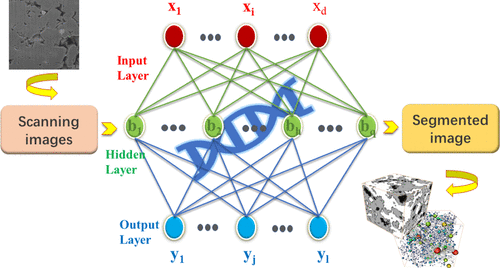Our official English website, www.x-mol.net, welcomes your feedback! (Note: you will need to create a separate account there.)
Application of the Backpropagation Neural Network Image Segmentation Method with Genetic Algorithm Optimization in Micropores of Intersalt Shale Reservoirs
ACS Omega ( IF 4.1 ) Pub Date : 2021-09-23 , DOI: 10.1021/acsomega.1c03041 Jie Zhao 1 , Maolin Zhang 2 , Chenchen Wang 2 , Zheng Mao 1 , Yizhong Zhang 2
ACS Omega ( IF 4.1 ) Pub Date : 2021-09-23 , DOI: 10.1021/acsomega.1c03041 Jie Zhao 1 , Maolin Zhang 2 , Chenchen Wang 2 , Zheng Mao 1 , Yizhong Zhang 2
Affiliation

|
The pore types of intersalt shale reservoirs are diverse, and the pore structures are relatively complex. The size of the pores ranges from a few nanometers to a few microns, showing obvious heterogeneity and multiscale. Image segmentation is an important link in the study of micropore structures of intersalt shale using digital core technology. It can identify characteristics such as pore category, shape, size, spatial distribution, and connectivity characteristics. Therefore, how to improve the accuracy of image segmentation becomes very important. In this study, the research object is the 10 rhythmic layers of the Qian 34 oil group in the Wangping 1 well area of oil field A. First, focused ion beam scanning electron microscopy was used to obtain core imaging data. Then, in order to realize efficient processing of two-dimensional image information and compensate for the shortcomings of conventional segmentation methods such as long iteration period, slow convergence speed, and low accuracy, the backpropagation (BP) neural network segmentation method with a genetic algorithm (GA) was adopted. Also, the segmentation results before and after the improvement were compared. The results show the following: (1) Among the selected intersalt shale core samples, 90% of the pore radius is less than 150 nm and more than 90% of the throats are less than 100 nm. (2) Compared with the conventional BP neural network, the number of convergence steps is reduced to 10, the speed is 10 times faster, and the porosity prediction accuracy is increased by 4.03% on average, which is closer to the gas-measured porosity value. It shows that the BP neural network image segmentation method with a GA has the advantages of small calibration error, fast convergence speed, high efficiency, and high precision.
中文翻译:

遗传算法优化的反向传播神经网络图像分割方法在层间页岩储层微孔中的应用
盐间页岩储层孔隙类型多样,孔隙结构较为复杂。孔隙大小从几纳米到几微米不等,表现出明显的异质性和多尺度性。图像分割是利用数字化核心技术研究盐间页岩微孔结构的重要环节。它可以识别孔隙类别、形状、大小、空间分布和连通性特征等特征。因此,如何提高图像分割的精度就变得非常重要。本研究以A油田望坪1井区黔34油组10个韵律层为研究对象,首先利用聚焦离子束扫描电镜获取岩心成像数据。然后,为了实现对二维图像信息的高效处理,弥补传统分割方法迭代周期长、收敛速度慢、精度低等缺点,采用遗传算法(GA)的反向传播(BP)神经网络分割方法) 被采纳。此外,还比较了改进前后的分割结果。结果表明: (1) 在选定的盐间页岩岩心样品中,90%的孔隙半径小于150 nm,超过90%的喉道小于100 nm。(2) 与常规BP神经网络相比,收敛步数减少到10,速度提高10倍,孔隙度预测精度平均提高4.03%,更接近气体实测孔隙度价值。
更新日期:2021-10-06
中文翻译:

遗传算法优化的反向传播神经网络图像分割方法在层间页岩储层微孔中的应用
盐间页岩储层孔隙类型多样,孔隙结构较为复杂。孔隙大小从几纳米到几微米不等,表现出明显的异质性和多尺度性。图像分割是利用数字化核心技术研究盐间页岩微孔结构的重要环节。它可以识别孔隙类别、形状、大小、空间分布和连通性特征等特征。因此,如何提高图像分割的精度就变得非常重要。本研究以A油田望坪1井区黔34油组10个韵律层为研究对象,首先利用聚焦离子束扫描电镜获取岩心成像数据。然后,为了实现对二维图像信息的高效处理,弥补传统分割方法迭代周期长、收敛速度慢、精度低等缺点,采用遗传算法(GA)的反向传播(BP)神经网络分割方法) 被采纳。此外,还比较了改进前后的分割结果。结果表明: (1) 在选定的盐间页岩岩心样品中,90%的孔隙半径小于150 nm,超过90%的喉道小于100 nm。(2) 与常规BP神经网络相比,收敛步数减少到10,速度提高10倍,孔隙度预测精度平均提高4.03%,更接近气体实测孔隙度价值。


























 京公网安备 11010802027423号
京公网安备 11010802027423号